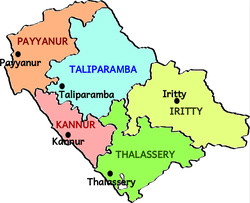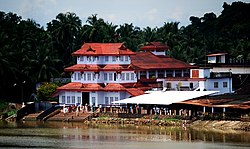Kannur district
Kannur District is one of the 14 districts along the west coast in the state of Kerala, India. The town of Kannur is the district headquarters and gives the district its name. The old name, Cannanore is the anglicised form of the Malayalam name "Kannur". Kannur district is bounded by Kasaragod District to the north, Kozhikode district to the south and Wayanad District to the southeast. To the east the district is bounded by the Western Ghats, which forms the border with the state of Karnataka (Kodagu district). The Arabian Sea is to the west. The district was established in 1957.
Kannur is the sixth-most urbanized district in Kerala, with more than 50% of its residents living in urban areas. Kannur has an urban population of 1,212,898, which is the second largest in Kerala after Ernakulam district.[1][2]
Kannur District is known as the land of looms and lores, because of the loom industries and ritualistic festivals held here in temples. The district is a major centre of Theyyam, a ritual dance of northern Kerala. Small shrines known as kavus, associated with the Theyyam, dot the district.
The proposed Kannur International Airport will be the fourth international airport in Kerala and is in Mattannur, 26-km away from Kannur.
Demographics
According to the 2011 census Kannur district has a population of 2,525,637,[3] roughly equal to the nation of Kuwait[4] or the US state of Nevada.[5] This gives it a ranking of 170th in India (out of a total of 640).[3] The district has a population density of 852 inhabitants per square kilometre (2,210/sq mi).[3] Its population growth rate over the decade 2001-2011 was 4.84%.[3] Kannur has a sex ratio of 1133 females for every 1000 males,[3] the highest among any district in India, and a literacy rate of 95.41%.[3]
The District has a population of 2,412,365 (2001 census). This was the most urbanised district in Kerala in 2001, but was pushed to 4th place after Ernakulam, Thrissur and Kozhikode in 2011.[6] About 50.35% of the population reside in the urban agglomerations. The total urban population of Kannur district is 1,212,898. This is the second largest urban population in Kerala after Ernakulam and is more than the population of a metro city.[7]
In the 2001 Indian Census Hindus made up 61.47% of the population; Christians 10.84%; and Muslims 27.63%.The majority of the Anglo-Indian community lives in the Kannur Cantonment and the surrounding areas of Thillery, No.3 Bazaar and Camp Bazaar. The high urban population is due to the 45 towns in the district which was the highest in Kerala as per 2001 census. 2011 census has Thrissur with 135 towns with Kannur having 67.[8]
Kannur District Media
An old map of India in 1804. Note that only Thalassery, Kozhikode, and Kochi, are marked as cities within the present-day state of Kerala
Estuary of Anjarakandi River
References
- ↑ "Archived copy" (PDF). Archived from the original (PDF) on 2010-11-28. Retrieved 2017-10-06.
{{cite web}}: CS1 maint: archived copy as title (link) - ↑ "Untitled Document". Archived from the original on 2014-07-25. Retrieved 2017-10-06.
- ↑ 3.0 3.1 3.2 3.3 3.4 3.5 "District Census 2011". Census2011.co.in. 2011. Retrieved 2011-09-30.
- ↑ US Directorate of Intelligence. "Country Comparison:Population". Archived from the original on 2011-09-27. Retrieved 2011-10-01.
Kuwait 2,595,62
- ↑ "2010 Resident Population Data". U. S. Census Bureau. Archived from the original on 2011-08-23. Retrieved 2011-09-30.
Nevada 2,700,551
- ↑ "Census of India Website : Office of the Registrar General & Census Commissioner, India". Archived from the original on 2007-05-14.
- ↑ "Census GIS India". Archived from the original on 2010-01-11. Retrieved 2009-08-27.
- ↑ http://www.censusindia.gov.in/2011-prov-results/paper2-vol2/data_files/kerala/Chapter_IV.pdf
Other websites
| Wikimedia Commons has media related to Lua error in Module:Commons_link at line 62: attempt to index field 'wikibase' (a nil value).. |
| Wikivoyage has a travel guide about: Kannur District |
- Official Website Archived 2009-04-27 at the Wayback Machine
- Best places in Kannur
- Kannur page - Official Website of Kerala Government Archived 2005-03-09 at the Wayback Machine
- Kannur Community Portal Archived 2008-07-01 at the Wayback Machine









